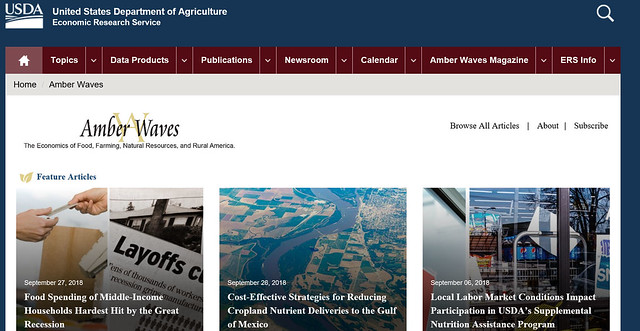
For the past decade and a half, ERS has been highlighting its research through its magazine, Amber Waves. As technology has evolved, so has Amber Waves, but the focus on bringing ERS’s latest agriculture and food research to readers in an engaging and user-friendly format has remained constant. In celebration of Amber Waves’ 15th Anniversary, we present a selection of its recent noteworthy stories and share its refreshed website.
Each month, readers can explore articles on topics ranging from trade issues to food safety to trends in rural America and the farm economy. Here are just a few examples of what readers can find in Amber Waves:
- Between 1995 and 2014, world agricultural trade nearly doubled when adjusted for inflation. Key factors driving this expansion include a more than 25-percent increase in the world’s population and about a 75-percent increase in the inflation-adjusted size of the world’s economy. Other factors have also stimulated agricultural trade, including falling trade barriers and technological advances in agricultural production, transportation, information, and communications. Learn more from this February 2018 article.
- Public disclosure of food safety performance information of poultry slaughter plants encouraged plants to improve food-safety practices and was correlated with fewer samples of broilers that tested positive for Salmonella over 2006-14. These findings led ERS researchers to conclude that this additional information enabled retailers, restaurants, nursing homes, and other large commercial buyers to seek out better performing plants, which encouraged all plants to improve food safety performance. Learn more from a May 2017 article.
- Agricultural production has shifted to larger farms over the last three decades. In 1987, more than half (57 percent) of all U.S. cropland was operated by midsize farms that had between 100 and 999 acres of cropland, while 15 percent was operated by large farms with at least 2,000 acres. Over the next 25 years, cropland shifted away from midsize and toward larger operations. By 2012, farms with 100-999 acres held 36 percent of cropland, the same share as that held by large farms. Read more from this March 2018 article.
Over the past 15 years, Amber Waves has built an audience of more than 5,000 e-mail subscribers, representing business, industry, researchers, and government. Originally printed five times a year, ERS posts new issues of Amber Waves monthly on the ERS website with additional articles released concurrently with new reports throughout the year. Last month, ERS launched a refresh of the Amber Waves website, based on reader feedback. New features include an easier-to-navigate homepage, improved filtering, and a new infographics gallery. We encourage you to keep reading Amber Waves, explore the new features and tell us what you think! For questions or comments, please email amberwaveseditor@usda.gov.
